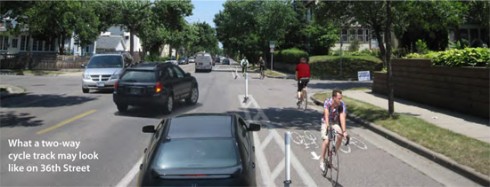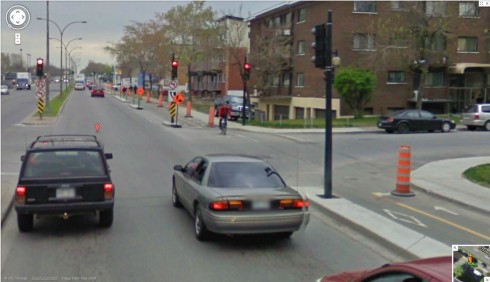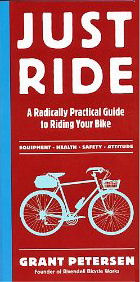I recently spent several hours riding in Montreal with a companion who was using the Bixi bike-share bicycles. These are similar if not identical to others being deployed in North American cities. I have some experience riding a Hubway bicycle in Boston, too.
These bicycles are designed to meet different requirements, compared with a rider-owned bicycle. A few observations:
- The user is relieved of the burden of servicing the bicycles. That is advantageous– there are no worries about flat tires or other mechanical problems. If a bicycle becomes unrideable, you walk it to the nearest rental stand and trade it for another. A related advantage, especially for city dwellers, is that there is no need to store or secure one’s own bicycle.
- The bicycles are rugged, and so they are heavy.
- The three-speed hubs are not overgeared, like those on classic three-speed bicycles. The top gear is about right for level-ground cruising. These bicycles climb better than the classic three-speed in the lower gears, but still, the limited gear range and weight of the bicycle make it unsuitable for steep climbs except when using the “two-foot gear” (that is: get off and walk). My companion found one Bixi bicycle with a Shimano 7-speed hub, which he used for part of our ride, but never found another despite looking for one among several dozens waiting at rental stands.
- The bicycles have fenders, integral lights powered by a generator in the front hub, and a (front) baggage rack, all features necessary for practical transportation use. Additional baggage capacity would be nice but would require a rear rack.
- The very low step-through frames and skirt guards either side of the rear wheel allow a person to straddle one of these bicycles even if hardly able to left a foot off the ground, and to ride in an ankle-length skirt.
- The skirt guards carry advertising logos — a reminder that the bike-share (actually, bike-rental) program doesn’t pay for itself.
- Many features of the bicycles are designed specifically to prevent vandalism and theft. Wheels are not removable using conventional tools, tire valves are not accessible, the seatpost cannot be pulled all the way out etc. Some of the anti-theft features come at the expense of performance…
- My companion found that the seatposts on most of these bicycles could not be extended far enough for full leg extension, though he is a full 5’7″ (170
cm) tall. - All the bicycles have flat pedals. If you prefer clip-in pedals or toe clips and straps, you’ll have to ride your own bicycle.
- The street-tread MTB tires are inflated rock-hard. Evidently, protecting the rims rates higher than rider comfort.
- Hub brakes — Shimano Rollerbrakes front and rear — allow rims to be out of alignment without affecting braking, but these brakes are weak. The front brake appears to have a power limiter, or else it is mismatched to the brake lever. Braking appears to reach a limit which does not increase, no matter how hard the lever is pulled. (I hope to do a braking distance test soon).
- The black, padded saddles get uncomfortably hot sitting in the sun on a summer day.
- The system recommends helmet use but doesn’t supply helmets. Boston is, as I understand, working on an automated helmet dispenser.
- In both Boston and Montreal, rental stands are consistently placed in the street with the rear of the bicycle facing out into the street. Some are on busy streets. You must walk in the street and back the bicycle out into the street to disengage it from its dock. In many cases, the rental stand is on a one-way street or a street with a median, so the user must walk in the street or ride opposite the legal direction of traffic to get to the through street or bikeway which it services. Usually, one-way streets lead away from the serviced street, and so the travel opposite traffic is almost always at the start of the trip.
- A user has to to walk to and from rental stands, same as bus stops. The bicycles don’t come with locks except to lock them to the rental stands. If you stop in mid-trip to have lunch or so shopping, you must bring your own lock, and the rental clock keeps running.
- The Montreal system offers a 24-hour pass, but extra charges accrue for any bicycle that is kept in use for more than 1/2 hour. At cycle-track speeds while obeying traffic signals, that was good for 4 miles (6 km) or less. My companion would note where a rental stand was at the right distance to switch bicycles just short of the half-hour limit. The system made him wait two minutes before he could release another bicycle at the same rental stand. Even one minute over the 1/2 hour adds a charge of $1.75 for the next half-hour. The payment plan, then, provides a strong economic disincentive against longer trips.
- Walk time seriously increases trip time beyond what it would be with the user’s own bicycle. On average, depending on distance of the start and end of the trip from the rental stand, the time overhead for a ride on one’s own bicycle is less even if it involves donning/removing special bicycling shoes, bicycle gloves and a helmet. There also is some uncertainty whether a bicycle will be available to start a trip, and whether there will be an empty space for docking at the end of a trip. Nonetheless, the program is popular.
I note that the on-street separated bikeways in Montreal have a speed limit of 20 km/h (12 mph). That is more or less what these bicycles are designed for. People riding their own bicycles commonly go faster. The design of the bike-share bicycles goes very much in the opposite direction from the racing spec hype that dominates the recreational cycling market.
All in all: when you ride one of these bicycles, you have been recruited into the bike mode share increase army. It’s like eating army food, which will fill your stomach but which is missing some of the nicer qualities of fancy cuisine or good home cooking. Or like sleeping in an army cot, which doesn’t quite compare with a bed in a fancy hotel, or your own bed at home. But then, an army provides for its soldiers, with a couple of tradeoffs, to be sure — the cost borne by the public at large, and the risk factor for soldiers.
Bike-share programs are structured as a public utility, as a form of public transit. The bicycles are requisitioned outside the usual stream of commerce of the bicycle retail industry. Whether the general sentiment in that industry is “a riding tide lifts all bikes” or that the competition is unfair, I don’t know. I did address that issue in an article I wrote for the sheldonbrown.com Web site on April 1, 2012 — please take note of that date when evaluating my article.




